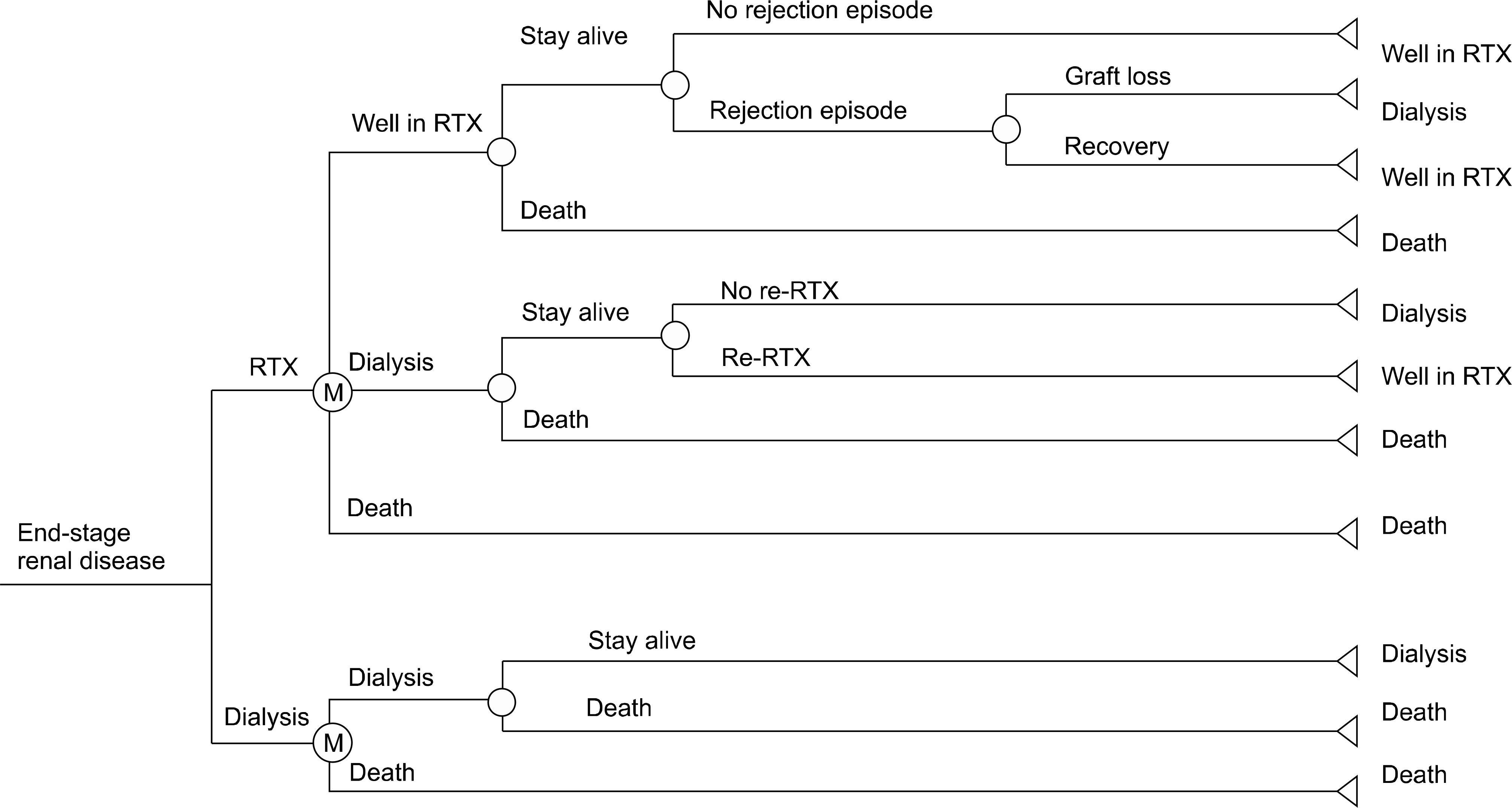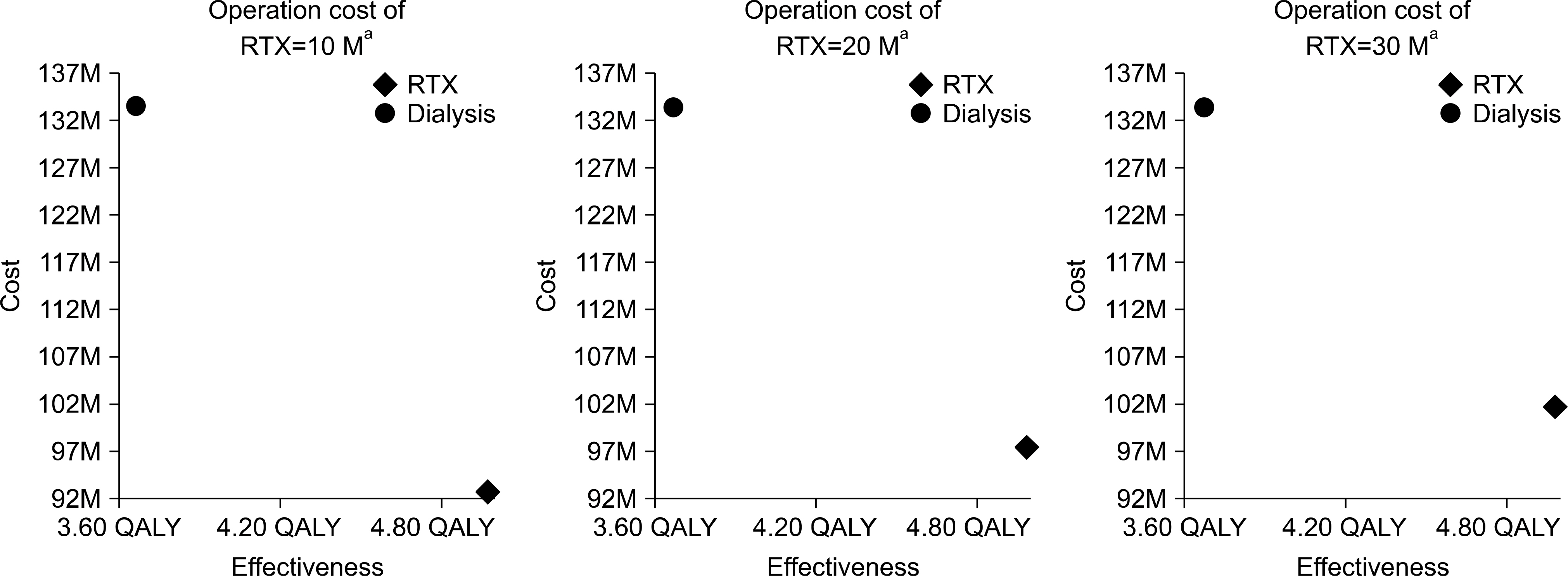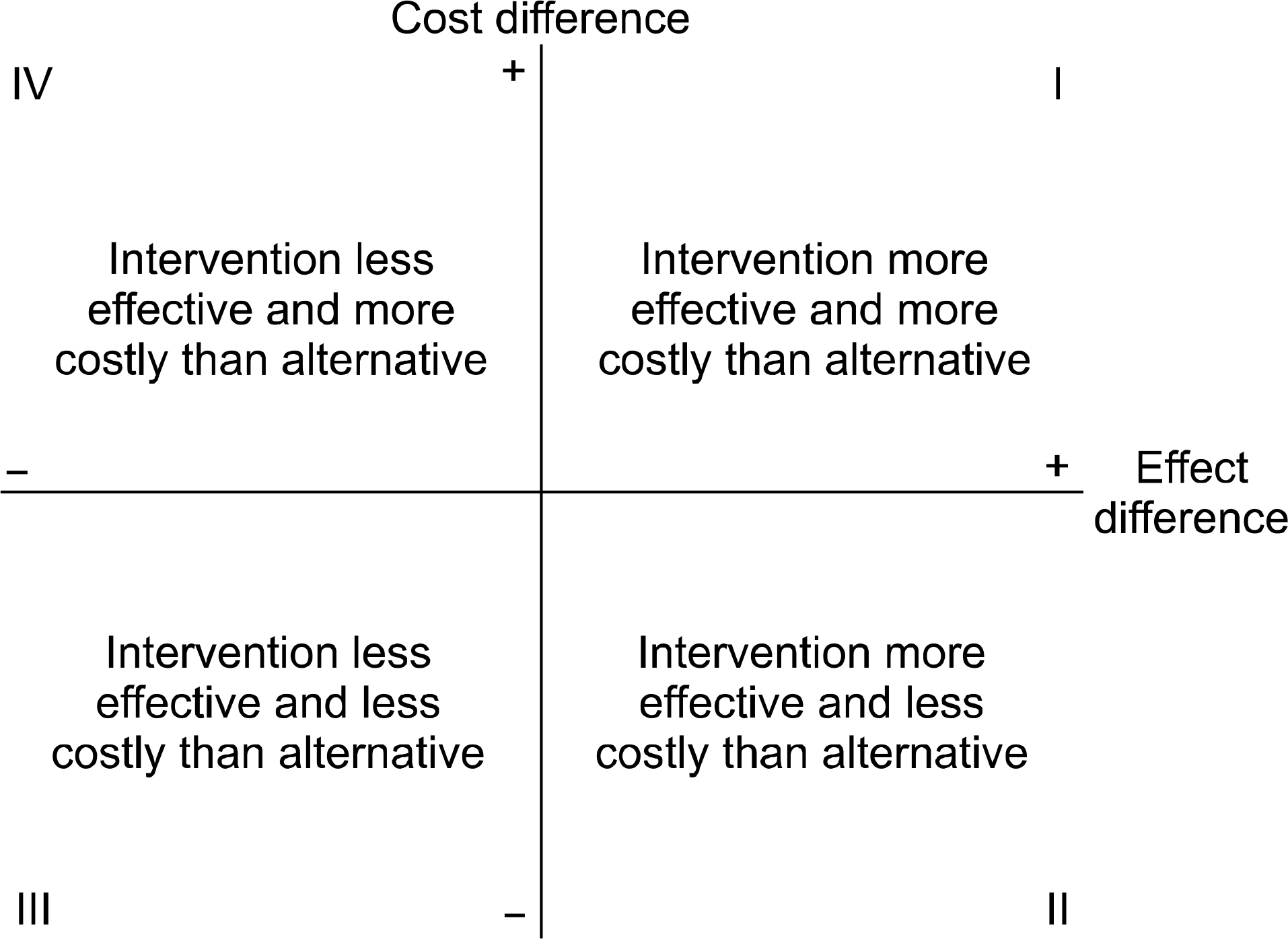J Korean Soc Transplant.
2010 Sep;24(3):173-181. 10.4285/jkstn.2010.24.3.173.
A Renal Transplantation and Hemodialysis Cost-Utility Analysis in Patients with End-Stage Renal Disease
- Affiliations
-
- 1Department of Surgery and the Research Institute for Transplantation, Yonsei University College of Medicine, Seoul, Korea.
- 2National Cancer Control Research Institute, National Cancer Center, Goyang, Korea.
- 3Severance Hospital Organ Transplant Center, Yonsei University, Gangnam, Korea.
- 4Severance Hospital Transplant Center, Yonsei University, Seoul, Korea.
- 5Department of Healthcare Management, College of Medical Science, Soonchunhyang University, Asan, Korea. hmi@sch.ac.kr
- KMID: 1464310
- DOI: http://doi.org/10.4285/jkstn.2010.24.3.173
Abstract
- BACKGROUND
The purpose of this study was to examine the cost-effectiveness of renal transplantation and hemodialysis among end-stage renal disease patients.
METHODS
Empirical data on treatment costs were collected from five hospitals in Korea. We used European Renal Association-European Dialysis and Transplant Association registry data for transition probability. Quality adjusted life year (QALY) values were derived from the literature. A Markov model was used for predicting the cost utility of transplantation and hemodialysis over a 10-year period.
RESULTS
Renal transplantation was less costly and resulted in a better outcome than hemodialysis. The cost per QALY gained was 19,450 thousand won in transplantation patients, whereas it was 36,514 thousand won per QALY gained in hemodialysis patients.
CONCLUSIONS
Although the cost of the first year after transplantation was expensive, transplantation was more effective over 2 years and was less costly than hemodialysis. The results suggest that transplantation is more cost-effective than hemodialysis in Korea.
Keyword
MeSH Terms
Figure
Cited by 1 articles
-
Quality of Life among End-stage Renal Disease Treatments and Economic Evaluation of Renal Transplantation and Hemodialysis Treatments
Kyung-Ock Jeon, Sun-Young Son, Myung-Il Hahm, Soon-Il Kim
J Korean Soc Transplant. 2015;29(4):200-208. doi: 10.4285/jkstn.2015.29.4.200.
Reference
-
References
1). Moeller S, Gioberge S, Brown G. ESRD patients in 2001: global overview of patients, treatment modalities and development trends. Nephrol Dial Transplant. 2002; 17:2071–6.
Article2). Howard K, Salkeld G. White S, McDonald S, Chadban S, Craig JC, et al. The cost-effectiveness of increasing kidney transplantation and home-based dialysis. Nephrology (Carlton). 2009; 14:123–32.
Article3). Cleemput I, Kesteloot K, Vanrenterghem Y, de Geest S. The economic implications of non-adherence after renal transplantation. Pharmacoeconomics. 2004; 22:1217–34.
Article4). Baboolal K, McEwan P, Sondhi S, Spiewanowski P, Wechowski J, Wilson K. The cost of renal dialysis in a UK setting – a multicentre study. Nephrol Dial Transplant. 2008; 23:1982–9.5). de Wit GA, Ramsteijn PG, de Charro FT. Economic evaluation of end stage renal disease treatment. Health Policy. 1998; 44:215–32.
Article6). Karlberg I, Nyberg G. Cost-effectiveness studies of renal transplantation. Int J Technol Assess Health Care. 1995; 11:611–22.
Article7). Sennfält K, Magnusson M, Carlsson P. Comparison of hemodialysis and peritoneal dialysis – a cost-utility analysis. Perit Dial Int. 2002; 22:39–47.
Article8). Quinton W, Dillard D, Scribner BH. Cannulation of blood vessels for prolonged hemodialysis. Trans Am Soc Artif Intern Organs. 1960; 6:104–13.
Article9). Kim MH, Kim MS, Kwon OJ, Kang CM. Comparison of quality of life between kidney transplant patients and dialysis patients. J Korean Soc Transplant. 2009; 23:65–70. (김명희, 김민수, 권오정, 강종명. 신장이식환자와 투석환자의 삶의 질 비교. 대한이식학회지 2009;23: 65–70.).
Article10). Laupacis A, Keown P, Pus N, Krueger H, Ferguson B, Wong C, et al. A study of the quality of life and cost-utility of renal transplantation. Kidney Int. 1996; 50:235–42.
Article11). Organisation for Economic Cooperation and Development (OECD) working party on Biotechnology. Draft final report of the new and emerging health-related technologies project. Paris: OECD;2004. p. 12.12). Drummond MF, Sculpher MJ, et al. Methods for economic evaluation of health care programes. 3rd ed.New York, NY: Oxford University Press;2005. : 40.13). Joish VN, Oderda GM. Cost-utility analysis and quality adjusted life years. J Pain Palliat Care Pharmacother. 2005; 19:57–61.
Article14). Tousignant P, Guttmann RD, Hollomby DJ. Transplantation and home hemodialysis: their cost-effectiveness. J Chronic Dis. 1985; 38:589–601.
Article15). Park HO, Bang WR, Kim SJ, Kim ST, Han JS, Kim S, et al. The quality of life of ESRD patient development of a tool and comparison between transplants and dialysis patients. J Korean Soc Transplant. 1991; 5:51–8. (박혜옥, 방활란, 김상준, 김수태, 이정상, 김성권, 등. 말기신질환자의 삶의 질: 측정도구 개발 및 이식과 투석환자의 비교. 대한이식학회지 1991;5: 51–8.).16). National Institute for Health and Clinical Excellence (NICE). Measuring effectiveness and cost effectiveness: the QALY [internet]. London: NICE;2010. Available from:. http://www.nice.org.uk/newsroom/features/measu-ringeffectivenessandcosteffectivenesstheqaly.jsp.17). Lee EK. Basic concept and practice in economic evaluation of health care program. The Korea Association of Health Technology Assessment (KAHTA) Forum. 2009 May 13; Seoul, Korea.Seoul: KAHTA;2009. (이의경. 의약품 경제성평가의 기본 개념과 실제. 2009년도 한국보건의료기술평가학회 춘계 학술대회; 2009년 5월 13일; 서울, 대한민국. 서울: 한국보건의료기술평가학회; 2009.).18). van Dijk PC, Jager KJ, de Charro F, Collart F, Cornet R, Dekker FW, et al. .;. ERA-EDTA registry. Renal replacement therapy in Europe: the results of a collaborative effort by the ERA-EDTA registry and six national or regional registries. Nephrol Dial Transplant. 2001; 16:1120–9.
Article19). Lee SY. Using the economic evaluation in making a decision on health insurance benefit of new drug. The Korea Association of Health Technology Assessment (KAHTA) Forum; 2009 May 13. Seoul, Korea.Seoul: KAHTA;2009. (이소영. 의약품 급여 결정 과정에서 경제성평가의 활용. 2009년도 한국보건의료기술평가학회 춘계 학술대회; 2009년 5월 13일; 서울, 대한민국. 서울: 한국보건의료기술평가학회; 2009.).20). Health Insurance Review and Assessment (HIRA) Service. Guidelines for economic evaluation of pharmaceuticals in Korea. Seoul: Health Insurance Review and Assessment Service;2006.21). Kontodimopoulos N, Niakas D. An estimate of lifelong costs and QALYs in renal replacement therapy based on patients' life expectancy. Health Policy. 2008; 86:85–96.
Article22). McFarlane P, Bayoumi A, Pierratos A, Redelmeier D. The impact of home nocturnal hemodialysis on end-stage renal disease therapies: a decision analysis. Kidney Int. 2006; 69:798–805.
Article23). Manns B, Meltzer D, Taub K, Donaldson C. Illustrating the impact of including future costs in economic evaluations: an application to end-stage renal disease care. Health Econ. 2003; 12:949–58.
Article24). Kim SG, Hahm MI, Choi KS, Seung NY, Shin HR, Park EC. The economic burden of cancer in Korea in 2002. Eur J Cancer Care (Engl). 2008; 17:136–44.
Article25). Kim J, Hahm MI, Park EC, Park JH, Park JH, Kim SE, et al. Economic burden of cancer in South Korea for the year 2005. J Prev Med Public Health. 2009; 42:190–8. (김진희, 함명일, 박은철, 박재현, 박종혁, 김성은, 등. 2005년 암의 경제적 비용부담 추계. 예방의학회지 2009;42: 190–8.).
Article26). Klarenbach S, Barnieh L, Gill J. Is living kidney donation the answer to the economic problem of end-stage renal disease? Semin Nephrol. 2009; 29:533–8.
Article27). Huh KH, Kim MS, Ju MK, Chang HK, Ahn HJ, Lee SH, et al. Exchange living-donor kidney transplantation: merits and limitations. Transplantation. 2008; 86:430–5.
Article28). Kim MS, Kim YS, Kim SI, Moon JI, Jeon KO, Park K. Factors affecting the first 3-year quality of graft function after live donor kidney transplantation. J Korean Surg Soc. 2000; 58:789–801. (김명수, 김유선, 김순일, 문장일, 전경옥, 박기일. 공여자 신장무게와 공여자의 나이가 이식신 기능에 미치는 영향. 대한외과학회지 2000;58: 789–801.).29). 국립장기이식관리센터 홈페이지. www.konos.go.kr. 2010.30). Park YJ, Kang H, Kim EM, Shin WY, Yi NJ, Suh KS, et al. Establishment of active identification and management system for potential brain dead donors in life-link center. J Korean Soc Transplant. 2009; 23:43–51. (박양진, 강현진, 김은만, 신우영, 이남준, 서경석, 등. 생명 연결본부: 능동적인 잠재뇌사자 발굴신고 및 뇌사장기기증자 관리체계 구축. 대한이식학회지 2009;23: 43–51.).31). Cho WH, Kim HT, Lee HJ, Seo YM, Lee SD, Son EI, et al. Development of Korean Model for Independent Organ Procurement Organization. J Korean Soc Transplant. 2008; 22:109–19. (조원현, 김형태, 이현진, 서영민, 이상도, 손은익, 등. 지역 장기구득기관의 한국형 모델 개발. 대한이식학회지 2008;22: 109–19.).
- Full Text Links
- Actions
-
Cited
- CITED
-
- Close
- Share
- Similar articles
-
- Quality of Life among End-stage Renal Disease Treatments and Economic Evaluation of Renal Transplantation and Hemodialysis Treatments
- Health technology assessment of kidney transplantation and hemodialysis for the treatment of end-stage kidney disease
- Phenomenology on the Hemodialysis Experience of Patients with End-Stage Renal Disease
- Survey on kidney transplantation awareness among hemodialysis patients at a single center in Japan
- Acquired Cystic Kidney Disease in Patients Undergoing Long-term Hemodialysis Treatment




